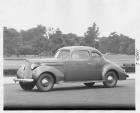|
Re: Last word on tail light visibility. If there is one.
|
||||
|---|---|---|---|---|
|
Forum Ambassador
|
That's a good question. I'd be curious if anyone in the hobby has ever done a direct comparison between gloss white, aluminum paint, stainless, plating or whatever. There are some sites that suggest reflective aluminized mylar sheeting is better than white paint.
I believe they painted the insides of the instrument cluster white as well but IIRC the postwar (at least 54 & 56) taillights are plain. Anyone with ideas on what they do on new cars? Believe some of the separate bulb headlights are sent to metalizing places for a silvering (or maybe it's aluminizing) these days so that must be the most reflective.
Posted on: 2012/9/17 22:00
|
|||
|
Howard
|
||||
|
||||
|
Re: Last word on tail light visibility. If there is one.
|
||||
|---|---|---|---|---|
|
Home away from home

|
I do recall reading an article in a magazine regarding the reflectability of silvering, painting and tinfoiling. I seem to recall that when they measured the light, they found that silvering reflected a high amount. I believe 90%. Wherease all other coatings/methods, the best that they could do was about 65%. I'll try to locate the article and report back if my memory is accurate.
Mark
Posted on: 2012/9/18 10:26
|
|||
|
||||








